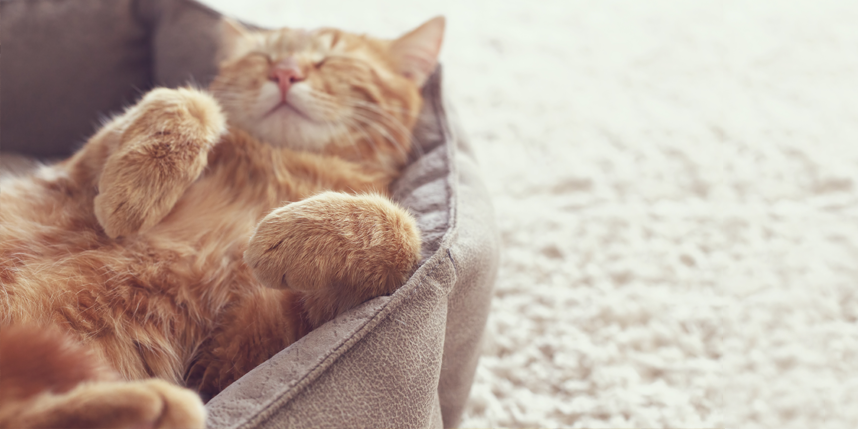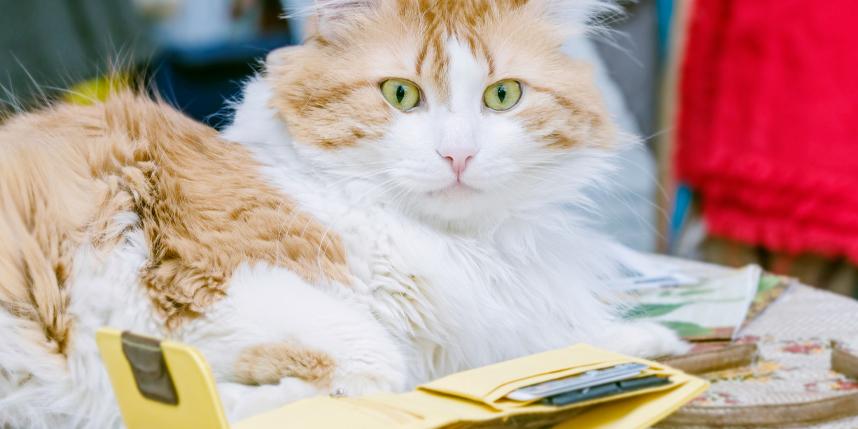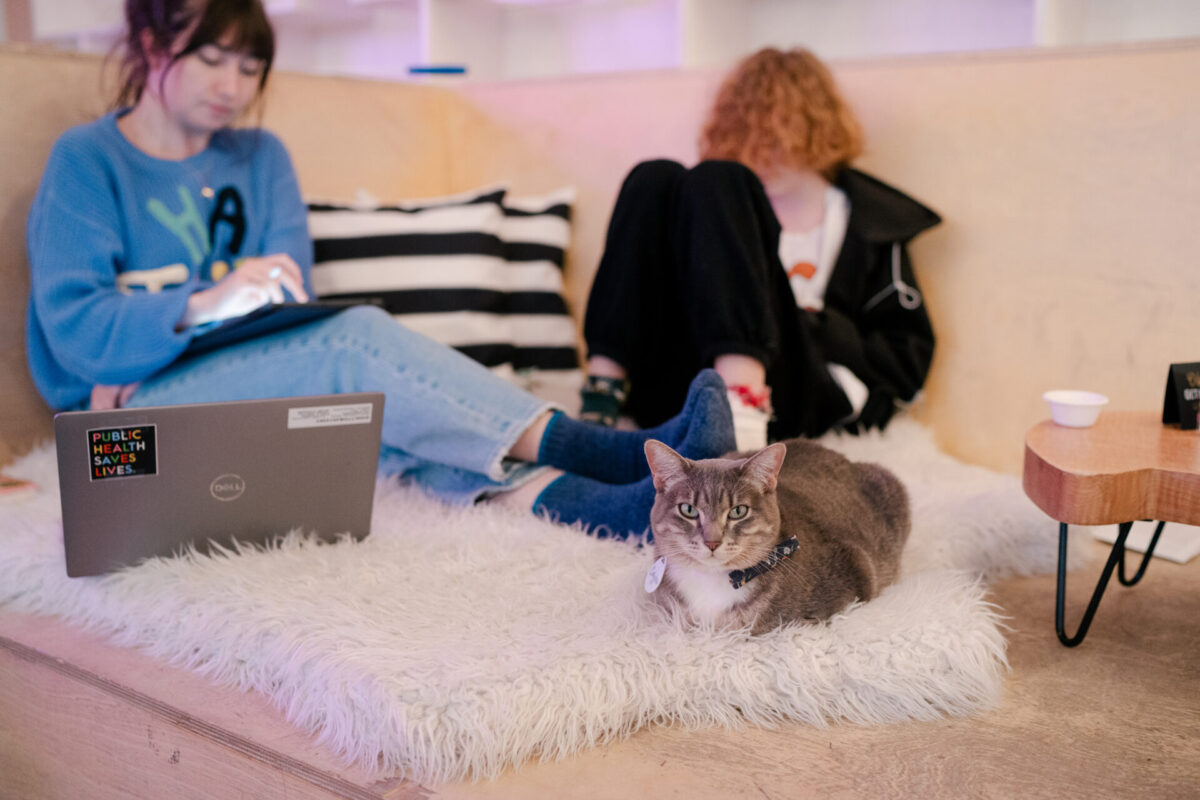INTRODUCING YOUR CAT TO A NEW DOG: A STEP-BY-STEP GUIDE
Cat care is especially important when introducing your kitty to a new dog. Use this simple advice when introducing the two species.

Five Ways to Achieve “Purr-vana”
Guest Blogger:
Daniel “DQ” Quagliozzi

When cat parents are in peril, they look to the behavior consultant that breaks the mold. Daniel “DQ” Quagliozzi is the behavior consultant behind Go, Cat, Go, San Francisco’s leading in-home resource for cat behavior advice. With over a decade of experience working for the San Francisco SPCA as a specialist in cat behavior, intake and adoption, Daniel brings a breadth of knowledge and a compassionate approach to his clients, sharing what he has learned on the front lines of animal welfare. DQ is partnering with World’s Best Cat Litter® to spread the word about the litter box solution that harnesses the concentrated power of corn to deliver a cleaner litter box with less litter.
Okay cat guardians, the mew year is upon us and it’s time to make some resolutions that are going to count for your cats. It takes a joint effort between cat and caretaker to make positive changes manifest in the right way. But if you succeed, a bounty of kitty satisfaction awaits in a place that I like to call, “Purr-vana”, where all of your cat’s needs are met in an environment that honors what it truly feels like to be a cat.
So how do you achieve Purr-vana? Does it really exist? As always, the answers are found in compromise…and yes… this is where you come in. Don’t expect your cat to do anything differently until you do the work to make the environment more cat-friendly. You must surrender yourself to the way of the cat.
Safe Places to Just Be
A safe place is one to which a cat can retreat when the energy in the room gets a little frenetic. Just like people, cats can be introverts or extroverts and their decisions are often framed around their preferences to be alone and hidden or out in the open. Some cats prefer to be up high where they can survey the landscape, or down low, where they can’t be detected. Wherever your cat likes to chill, it’s essential that you provide the right accommodations to fit their individual purr-sonalities.
There is a brave new world of cat furniture out there these days. You don’t have to suffer with an old school, beige on beige carpeted cat tree anymore. If you look for it, you can find cat furniture that meets the needs of your cat, respects the aesthetic in your home and fits your budget. You can catify to satisfy with modern designed cat trees, shelving, perches and hiding places that will fit into any décor and allow your cat to retreat or climb to safety. The choice is yours to make. Hide or take pride! What’s most important is that you balance out the environment for the both of you.
Choice Instead of Competition
Cats are selfish creatures. They only do things or go places that are in their best interests. So, when they live in groups or in solitude, they prefer to keep competition at a minimum. Important resources, like feeding stations, litter boxes, scratching areas and locations designated for rest are typically subject to tension and competition if they are all located in the same place, or if there are just not enough of them to go around. Areas of your home where cats may bottleneck into a corner or a confined area may contribute to existing tensions within the dynamic of your cats.
As a general rule, you should supply one individual resource for each cat in your home, plus some extras to break that tie. This is especially true for litter box locations and feeding areas. Sure, it’s a positive experience for your cats to share a meal in the same location; however, if you observe competition or sense insecurity as a result, then it’s time to make a change.
Spread out your litter boxes, feeding areas, scratching posts, pads and cat furniture the best that you can in the space that you have. I know it can be particularly challenging in a small apartment to provide multiple resources, but remember that it’s essential for a cat to feel as if they have the free will to do as they please, without anything or anyone getting in the way of that decision.
Play and Prey
The average house cat is pretty bored. After a long relaxing day of sleep, they wake in the early evening to seek hunting opportunities, but are reliably disappointed by a deficit in activity, or the same old lack-luster play routine. Most cat guardians can fit in a play session or two each day, but even that may not be enough for one cat with a high prey drive. There is no way around it. You have to provide realistic and engaging opportunities for the hunt, or that high prey drive is going to bottle up and blow.
I always say, it’s extremely important to “keep it real” when playing with your cat! Move interactive toys like prey would move. Use the walls. Dart around corners and table legs. Hide the toy underneath rugs, pillows or virtually any object, and your cat will be hooked on the hunt.
Also, remember to change it up. The same old nemesis mouse appearing day after day can get pretty tired, so rotate your top five and keep your cat guessing. It’s ultimately up to you to make your cat’s day, so be sure to bring your A-game.
Positively Predictable
Cats learn through a positive association with new experiences, and they take very calculated risks when an outcome may be uncertain or if their freedom of choice is compromised. Allowing a cat to call the shots while providing rewards for the behaviors that benefit you both is the key to this conditional relationship. Cats are most happy when they can predict the benefits of the day to come and if it pans out the way they expected. Of course, they are always expecting things to weigh in their favor.
If you have a cat, you know that you can’t force them to do anything. They go where they want to go and do what they want to do with no regret and zero remorse. Mostly, they are just looking to benefit from their experiences. When you lessen your intentions toward them and allow them to choose how an interaction will go, the rewards are far greater. Cats often seize these opportunities to take ownership and be social. Ask any cat. Less is more.
Respect to Scent
Cats use olfactory and chemical information to get a sense of their surroundings and to maximize their sense of security and comfort. They can feel displaced or anxious when their territories have strong or foreign odors that they cannot identify, which can sometimes manifest as misbehavior like marking or territorial aggression, if not identified or addressed.
Guardians should be careful not to interfere with scent profiles left behind by individual cats, or group scents that are representative of all the cats in the house. Provide the right kind of marking opportunities, like scratching posts and cardboard or sisal scratch pads, and be conscious of where your cat chooses to facially mark. These are locations that your cat thinks very highly of or areas of high social significance.
Do not use harsh or strongly-scented deodorizers or cat litters, and avoid cleaning areas that your cat chooses to rub against with the face or side flanks. Pheromone diffusers like Feliway can be useful in changing the impression of an area that is being competed for or marked.
The answers will always lie in the options provided. Give your cats the freedom to make a choice, and the path to “Purr-vana” is easy to follow.



